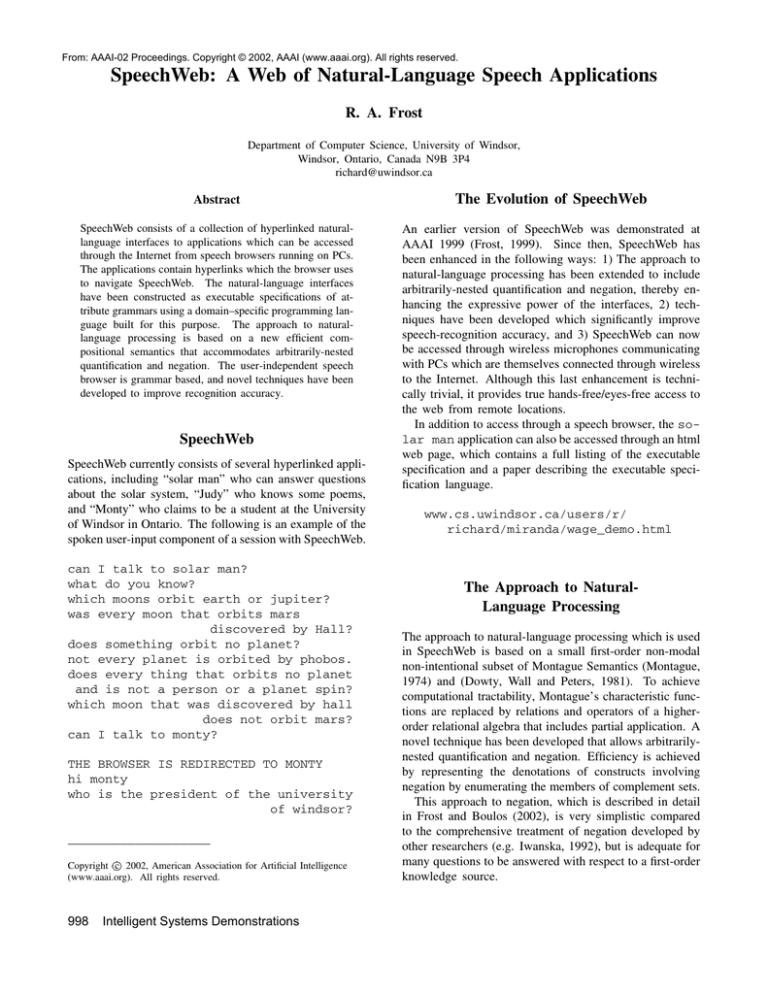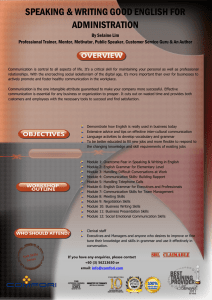
From: AAAI-02 Proceedings. Copyright © 2002, AAAI (www.aaai.org). All rights reserved.
SpeechWeb: A Web of Natural-Language Speech Applications
R. A. Frost
Department of Computer Science, University of Windsor,
Windsor, Ontario, Canada N9B 3P4
richard@uwindsor.ca
Abstract
The Evolution of SpeechWeb
SpeechWeb consists of a collection of hyperlinked naturallanguage interfaces to applications which can be accessed
through the Internet from speech browsers running on PCs.
The applications contain hyperlinks which the browser uses
to navigate SpeechWeb. The natural-language interfaces
have been constructed as executable specifications of attribute grammars using a domain–specific programming language built for this purpose. The approach to naturallanguage processing is based on a new efficient compositional semantics that accommodates arbitrarily-nested
quantification and negation. The user-independent speech
browser is grammar based, and novel techniques have been
developed to improve recognition accuracy.
An earlier version of SpeechWeb was demonstrated at
AAAI 1999 (Frost, 1999). Since then, SpeechWeb has
been enhanced in the following ways: 1) The approach to
natural-language processing has been extended to include
arbitrarily-nested quantification and negation, thereby enhancing the expressive power of the interfaces, 2) techniques have been developed which significantly improve
speech-recognition accuracy, and 3) SpeechWeb can now
be accessed through wireless microphones communicating
with PCs which are themselves connected through wireless
to the Internet. Although this last enhancement is technically trivial, it provides true hands-free/eyes-free access to
the web from remote locations.
In addition to access through a speech browser, the solar man application can also be accessed through an html
web page, which contains a full listing of the executable
specification and a paper describing the executable specification language.
SpeechWeb
SpeechWeb currently consists of several hyperlinked applications, including “solar man” who can answer questions
about the solar system, “Judy” who knows some poems,
and “Monty” who claims to be a student at the University
of Windsor in Ontario. The following is an example of the
spoken user-input component of a session with SpeechWeb.
can I talk to solar man?
what do you know?
which moons orbit earth or jupiter?
was every moon that orbits mars
discovered by Hall?
does something orbit no planet?
not every planet is orbited by phobos.
does every thing that orbits no planet
and is not a person or a planet spin?
which moon that was discovered by hall
does not orbit mars?
can I talk to monty?
THE BROWSER IS REDIRECTED TO MONTY
hi monty
who is the president of the university
of windsor?
___________________
Copyright c 2002, American Association for Artificial Intelligence
(www.aaai.org). All rights reserved.
998
Intelligent Systems Demonstrations
www.cs.uwindsor.ca/users/r/
richard/miranda/wage_demo.html
The Approach to NaturalLanguage Processing
The approach to natural-language processing which is used
in SpeechWeb is based on a small first-order non-modal
non-intentional subset of Montague Semantics (Montague,
1974) and (Dowty, Wall and Peters, 1981). To achieve
computational tractability, Montague’s characteristic functions are replaced by relations and operators of a higherorder relational algebra that includes partial application. A
novel technique has been developed that allows arbitrarilynested quantification and negation. Efficiency is achieved
by representing the denotations of constructs involving
negation by enumerating the members of complement sets.
This approach to negation, which is described in detail
in Frost and Boulos (2002), is very simplistic compared
to the comprehensive treatment of negation developed by
other researchers (e.g. Iwanska, 1992), but is adequate for
many questions to be answered with respect to a first-order
knowledge source.
W/AGE: An Attribute-Grammar
Programming Language
The natural-language interfaces are constructed as executable specifications of attribute grammars (Paaki, 1995)
using the Windsor Attribute Grammar Programming Environment W/AGE (Frost, 1994). This language was built to
enable the rapid construction of language processors that
are based on compositional semantics.
The URL given earlier provides access to the W/AGE
code for the “solar man” application. In summary, the
program consists of a set of attribute type declarations, a
dictionary defining the syntactic types and denotations of
basic words (and the definition of other words as having
the same meaning as a given phrase), a set of attributegrammar productions in which syntax rules are augmented
with semantic rules showing how the attributes of a compound phrase are computed from the attributes of the components of that phrase, and finally a set of definitions of
semantic functions which provide links to the knowledge
source.
Improving Speech-Recognition Accuracy
The SpeechWeb browser is constructed as a Java program
linked to IBM’s ViaVoice speech-recognition engine. This
engine is grammar based in that it requires a “recognition
grammar” to constrain the search space. The browser
begins by downloading the recognition grammar from the
remote location. The recognition engine is then specialized
with this grammar. When an utterance is recognized, it is
sent to the remote application for processing. If a hyperlink
is returned, the browser is redirected to another location and
a new grammar is downloaded from that site.
Recognition accuracy is improved if the recognition
grammars define small languages. Rather than use conventional techniques for constraining the size of the input language (for example by restricting the vocabulary or
range of syntactic constructs) we use an alternative technique which involves modifying the recognition grammar
so that semantic constraints are “implemented” in the syntax. For example, the semantic constraint that a person
cannot orbit anything (with respect to the solar-man database) is integrated into the syntax of the recognition grammar. This, and other similar restrictions on what can be
recognized, has minimal impact on the user-friendliness
of the interface, but results in significant improvement in
recognition accuracy.
Future Research
Surprisingly little work has been done on the development of rules to assist in the design of hyperlinked speech
applications. Constructing an application as a large collection of hyperlinked units, each having a small input language, can improve recognition accuracy if the user knows
what s/he is allowed to say at each application. However,
this approach complicates navigation, and makes it harder
for the user to learn the scope of the input language. Guidelines need to be developed to help achieve a good compromise between recognition accuracy and ease of navigation.
Also, very few guidelines are available which help in the
design of recognition grammars.
In addition to the development of design guidelines to
improve navigation and recognition accuracy, current work
is directed at developing formal systems for the analysis
and reformulation of queries, and for answer justification.
Acknowledgments
Many people at the University of Windsor have contribute to SpeechWeb. In particular, the author would like
to thank Sanjay Chitte, Barbara Szydlowski, Tarek Haddad,
Stephen Karamatos, Walid Mnaymneh, and Kunal Bhatia.
The author acknowledges the support provided by NSERC
in the form of an individual research grant.
References
Dowty, D. R., Wall, R. E. and Peters, S. 1981. Introduction
to Montague Semantics. D. Reidel Publishing Company,
Dordrecht, Boston, Lancaster, Tokyo.
Frost, R. A., and Boulos, P. 2002. An Efficient Compositional Semantics for Natural-Language Database Queries
with Arbitrarily-Nested Quantification and Negation. Accepted for presentation at the Fifteenth Canadian Conference on Artificial Intelligence, AI’2002, to be held in Calgary in May 2002.
Frost, R. A. 1999. A Natural-Language Speech Interface
Constructed Entirely as a Set of Executable Specifications.
In Proceedings of the Intelligent Systems Demonstrations,
of the Eleventh National Conference on Artificial Intelligence, 908–909. AAAI’99 , Orlando, Florida: AAAI Press.
Frost, R. A. 1994. W/AGE The Windsor Attribute Grammar Programming Environment. Schloss Dagstuhl International Workshop on Functional programming in the Real
World.
Iwanska, L. 1992 A General Semantic Model of Negation in
Natural Language: Representation and Inference. Doctoral
Thesis, Computer Science, University of Illinois at UrbanaChampaign.
Paaki, J. 1995. Attribute grammar paradigms — a highlevel methodology in language implementation, ACM Computing Surveys 27(2) 196–255.
Intelligent Systems Demonstrations
999





